Appendix C to Part 121 - C-46 Nontransport Category Airplanes
14:3.0.1.1.7.32.3.1.9 : Appendix C
Appendix C to Part 121 - C-46 Nontransport Category Airplanes Cargo
Operations
1. Required engines. (a) Except as provided in paragraph
(b) of this section, the engines specified in subparagraphs (1) or
(2) of this section must be installed in C-46 nontransport category
airplanes operated at gross weights exceeding 45,000 pounds:
(1) Pratt and Whitney R2800-51-M1 or R2800-75-M1 engines
(engines converted from basic model R2800-51 or R2800-75 engines in
accordance with FAA approved data) that -
(i) Conform to Engine Specification 5E-8;
(ii) Conform to the applicable portions of the operator's
manual;
(iii) Comply with all the applicable airworthiness directives;
and
(iv) Are equipped with high capacity oil pump drive gears in
accordance with FAA approved data.
(2) Other engines found acceptable by the Flight Standards
office having type certification responsibility for the C-46
airplane.
(b) Upon application by an operator conducting cargo operations
with nontransport category C-46 airplanes between points within the
State of Alaska, the responsible Flight Standards office may
authorize the operation of such airplanes, between points within
the State of Alaska; without compliance with paragraph (a) of this
section if the operator shows that, in its area of operation,
installation of the modified engines is not necessary to provide
adequate cooling for single-engine operations. Such authorization
and any conditions or limitations therefor is made a part of the
Operations Specifications of the operator.
2. Minimum acceptable means of complying with the special
airworthiness requirements. Unless otherwise authorized under §
121.213, the data set forth in sections 3 through 34 of this
appendix, as correlated to the C-46 nontransport category airplane,
is the minimum means of compliance with the special airworthiness
requirements of §§ 121.215 through 121.281.
3. Susceptibility of material to fire. [Deleted as
unnecessary]
4. Cabin interiors. C-46 crew compartments must meet all
the requirements of § 121.215, and, as required in § 121.221, the
door between the crew compartment and main cabin (cargo)
compartment must be flame resistant.
5. Internal doors. Internal doors, including the crew to
main cabin door, must meet all the requirements of § 121.217.
6. Ventilation. Standard C-46 crew compartments meet the
ventilation requirements of § 121.219 if a means of ventilation for
controlling the flow of air is available between the crew
compartment and main cabin. The ventilation requirement may be met
by use of a door between the crew compartment and main cabin. The
door need not have louvers installed; however, if louvers are
installed, they must be controllable.
7. Fire precautions. Compliance is required with all the
provisions of § 121.221.
(a) In establishing compliance with this section, the C-46 main
cabin is considered as a Class A compartment if -
(1) The operator utilizes a standard system of cargo loading and
tiedown that allows easy access in flight to all cargo in such
compartment, and, such system is included in the appropriate
portion of the operator's manual; and
(2) A cargo barrier is installed in the forward end of the main
cabin cargo compartment. The barrier must -
(i) Establish the most forward location beyond which cargo
cannot be carried;
(ii) Protect the components and systems of the airplane that are
essential to its safe operation from cargo damage; and
(iii) Permit easy access, in flight, to cargo in the main cabin
cargo compartment.
The barrier may be a cargo net or a network of steel cables or
other means acceptable to the Administrator which would provide
equivalent protection to that of a cargo net. The barrier need not
meet crash load requirements of FAR § 25.561; however, it must be
attached to the cargo retention fittings and provide the degree of
cargo retention that is required by the operators' standard system
of cargo loading and tiedown.
(b) C-46 forward and aft baggage compartments must meet, as a
minimum, Class B requirements of this section or be placarded in a
manner to preclude their use as cargo or baggage compartments.
8. Proof of compliance. The demonstration of compliance
required by § 121.223 is not required for C-46 airplanes in which
-
(1) The main cabin conforms to Class A cargo compartment
requirements of § 121.219; and
(2) Forward and aft baggage compartments conform to Class B
requirements of § 121.221, or are placarded to preclude their use
as cargo or baggage compartments.
9. Propeller deicing fluid. No change from the
requirements of § 121.225. Isopropyl alcohol is a combustible fluid
within the meaning of this section.
10. Pressure cross-feed arrangements, location of fuel tanks,
and fuel system lines and fittings. C-46 fuel systems which
conform to all applicable Curtiss design specifications and which
comply with the FAA type certification requirements are in
compliance with the provisions of §§ 121.227 through 121.231.
11. Fuel lines and fittings in designated fire zones. No
change from the requirements of § 121.233.
12. Fuel valves. Compliance is required with all the
provisions of § 121.235. Compliance can be established by showing
that the fuel system conforms to all the applicable Curtiss design
specifications, the FAA type certification requirements, and, in
addition, has explosion-proof fuel booster pump electrical selector
switches installed in lieu of the open contact type used
originally.
13. Oil lines and fittings in designated fire zones. No
change from the requirements of § 121.237.
14. Oil valves. C-46 oil shutoff valves must conform to
the requirements of § 121.239. In addition, C-46 airplanes using
Hamilton Standard propellers must provide, by use of stand pipes in
the engine oil tanks or other approved means, a positive source of
oil for feathering each propeller.
15. Oil system drains. The standard C-46 “Y” drains
installed in the main oil inlet line for each engine meet the
requirements of § 121.241.
16. Engine breather line. The standard C-46 engine
breather line installation meets the requirements of § 121.243 if
the lower breather lines actually extend to the trailing edge of
the oil cooler air exit duct.
17. Firewalls and firewall construction. Compliance is
required with all of the provisions of §§ 121.245 and 121.247. The
following requirements must be met in showing compliance with these
sections:
(a) Engine compartment. The engine firewalls of the C-46
airplane must -
(1) Conform to type design, and all applicable airworthiness
directives;
(2) Be constructed of stainless steel or approved equivalent;
and
(3) Have fireproof shields over the fairleads used for the
engine control cables that pass through each firewall.
(b) Combustion heater compartment. C-46 airplanes must
have a combustion heater fire extinguishing system which complies
with AD-49-18-1 or an FAA approved equivalent.
18. Cowling. Standard C-46 engine cowling (cowling of
aluminum construction employing stainless steel exhaust shrouds)
which conforms to the type design and cowling configurations which
conform to the C-46 transport category requirements meet the
requirements of § 121.249.
19. Engine accessory section diaphragm. C-46 engine
nacelles which conform to the C-46 transport category requirements
meet the requirements of § 121.251. As provided for in that
section, a means of equivalent protection which does not require
provision of a diaphragm to isolate the engine power section and
exhaust system from the engine accessory compartment is the
designation of the entire engine compartment forward of and
including the firewall as a designated fire zone, and the
installation of adequate fire detection and fire extinguishing
systems which meet the requirements of § 121.263 and § 121.273,
respectively, in such zone.
20. Powerplant fire protection. C-46 engine compartments
and combustion heater compartments are considered as designated
fire zones within the meaning of § 121.253.
21. Flammable fluids -
(a) Engine compartment. C-46 engine compartments which
conform to the type design and which comply with all applicable
airworthiness directives meet the requirements of § 121.255.
(b) Combustion heater compartment. C-46 combustion heater
compartments which conform to type design and which meet all the
requirements of AD-49-18-1 or an FAA approved equivalent meet the
requirements of § 121.255.
22. Shutoff means -
(a) Engine compartment. C-46 engine compartments which
comply with AD-62-10-2 or FAA approved equivalent meet the
requirements of § 121.257 applicable to engine compartments, if, in
addition, a means satisfactory to the Administrator is provided to
shut off the flow of hydraulic fluid to the cowl flap cylinder in
each engine nacelle. The shutoff means must be located aft of the
engine firewall. The operator's manual must include, in the
emergency portion, adequate instructions for proper operation of
the additional shutoff means to assure correct sequential
positioning of engine cowl flaps under emergency conditions. In
accordance with § 121.315, this positioning must also be
incorporated in the emergency section of the pilot's checklist.
(b) Combustion heater compartment. C-46 heater
compartments which comply with paragraph (5) of AD-49-18-1 or FAA
approved equivalent meet the requirements of § 121.257 applicable
to heater compartments if, in addition, a shutoff valve located
above the main cabin floor level is installed in the alcohol supply
line or lines between the alcohol supply tank and those alcohol
pumps located under the main cabin floor. If all of the alcohol
pumps are located above the main cabin floor, the alcohol shutoff
valve need not be installed. In complying with paragraph (5) of
AD-49-18-1, a fail-safe electric fuel shutoff valve may be used in
lieu of the manually operated valve.
23. Lines and fittings - (a) Engine compartment.
C-46 engine compartments which comply with all applicable
airworthiness directives, including AD-62-10-2, by using FAA
approved fire-resistant lines, hoses, and end fittings, and engine
compartments which meet the C-46 transport category requirements,
meet the requirements of § 121.259.
(b) Combustion heater compartments All lines, hoses, and
end fittings, and couplings which carry fuel to the heaters and
heater controls, must be of FAA approved fire-resistant
construction.
24. Vent and drain lines - (a) Enginecompartment.
C-46 engine compartments meet the requirements of § 121.261 if
-
(1) The compartments conform to type design and comply with all
applicable airworthiness directives or FAA approved equivalent;
and
(2) Drain lines from supercharger case, engine-driven fuel pump,
and engine-driven hydraulic pump reach into the scupper drain
located in the lower cowling segment.
(b) Combustion heater compartment. C-46 heater
compartments meet the requirements of § 121.261 if they conform to
AD-49-18-1 or FAA approved equivalent.
25. Fire-extinguishing system. (a) To meet the
requirements of § 121.263, C-46 airplanes must have installed fire
extinguishing systems to serve all designated fire zones. The
fire-extinguishing systems, the quantity of extinguishing agent,
and the rate of discharge shall be such as to provide a minimum of
one adequate discharge for each designated fire zone. Compliance
with this provision requires the installation of a separate fire
extinguisher for each engine compartment. Insofar as the engine
compartment is concerned, the system shall be capable of protecting
the entire compartment against the various types of fires likely to
occur in the compartment.
(b) Fire-extinguishing systems which conform to the C-46
transport category requirements meet the requirements set forth in
paragraph (a). Furthermore, fire-extinguishing systems for
combustion heater compartments which conform to the requirements of
AD-49-18-1 or an FAA approved equivalent also meet the requirements
in paragraph (a).
In addition, a fire-extinguishing system for C-46 airplanes
meets the adequacy requirement of paragraph (a) if it provides the
same or equivalent protection to that demonstrated by the CAA in
tests conducted in 1941 and 1942, using a CW-20 type engine nacelle
(without diaphragm). These tests were conducted at the Bureau of
Standards facilities in Washington, DC, and copies of the test
reports are available through the FAA Regional Engineering Offices.
In this connection, the flow rates and distribution of
extinguishing agent substantiated in American Airmotive Report No.
128-52-d, FAA approved February 9, 1953, provides protection
equivalent to that demonstrated by the CAA in the CW-20 tests. In
evaluating any C-46 fire-extinguishing system with respect to the
aforementioned CW-20 tests, the Administration would require data
in a narrative form, utilizing drawings or photographs to show at
least the following:
Installation of containers; installation and routing of
plumbing; type, number, and location of outlets or nozzles; type,
total volume, and distribution of extinguishing agent; length of
time required for discharging; means for thermal relief, including
type and location of discharge indicators; means of discharging,
e.g., mechanical cutterheads, electric cartridge, or other method;
and whether a one- or two-shot system is used; and if the latter is
used, means of cross-feeding or otherwise selecting distribution of
extinguishing agent; and types of materials used in makeup of
plumbing.
High rate discharge (HRD) systems using agents such as
bromotrifluoromethane, dibrodifluoromethane and chlorobromomethane
(CB), may also meet the requirements of paragraph (a).
26. Fire-extinguishing agents, Extinguishing agent container
pressure relief, Extinguishing agent container compartment
temperatures, and Fire-extinguishing system materials. No
change from the requirements of §§ 121.265 through 121.271.
27. Fire-detector system. Compliance with the
requirements of § 121.273 requires that C-46 fire detector systems
conform to:
(a) AD-62-10-2 or FAA approved equivalent for engine
compartments; and
(b) AD-49-18-1 or FAA approved equivalent for combustion heater
compartments
28. Fire detectors. No change from the requirements of §
121.275.
29. Protection of other airplane components against fire.
To meet the requirements of § 121.277, C-46 airplanes must -
(a) Conform to the type design and all applicable airworthiness
directives; and
(b) Be modified or have operational procedures established to
provide additional fire protection for the wheel well door aft of
each engine compartment. Modifications may consist of improvements
in sealing of the main landing gear wheel well doors. An
operational procedure which is acceptable to the Agency is one
requiring the landing gear control to be placed in the up position
in case of in-flight engine fire. In accordance with § 121.315,
such procedure must be set forth in the emergency portion of the
operator's emergency checklist pertaining to in-flight engine
fire.
30. Control of engine rotation. C-46 propeller feathering
systems which conform to the type design and all applicable
airworthiness directives meet the requirements of § 121.279.
31. Fuel system independence. C-46 fuel systems which
conform to the type design and all applicable airworthiness
directives meet the requirements of § 121.281.
32. Induction system ice prevention. The C-46 carburetor
anti-icing system which conforms to the type design and all
applicable airworthiness directives meets the requirements of §
121.283.
33. Carriage of cargo in passenger compartments. Section
121.285 is not applicable to nontransport category C-46 cargo
airplanes.
34. Carriage of cargo in cargo compartments. A standard
cargo loading and tiedown arrangement set forth in the operator's
manual and found acceptable to the Administrator must be used in
complying with § 121.287.
35. Performance data. Performance data on Curtiss model
C-46 airplane certificated for maximum weight of 45,000 and 48,000
pounds for cargo-only operations.
1. The following performance limitation data, applicable to the
Curtiss model C-46 airplane for cargo-only operation, must be used
in determining compliance with §§ 121.199 through 121.205. These
data are presented in the tables and figures of this appendix.
Table 1 - Takeoff Limitations
(a) Curtiss C-46 certificated for maximum weight of 45,000
pounds.
(1) Effective length of runway required when effective
length is determined in accordance with § 121.171 (distance to
accelerate to 93 knots TIAS and stop, with zero wind and zero
gradient). (Factor = 1.00)
| Standard altitude
in feet |
Airplane weight
in pounds |
| 39,000 |
42,000 |
45,000 1 |
| S.L |
4,110 |
4,290 |
4,570 |
| 1,000 |
4,250 |
4,440 |
4,720 |
| 2,000 |
4,400 |
4,600 |
4,880 |
| 3,000 |
4,650 |
4,880 |
5,190 |
| 4,000 |
4,910 |
5,170 |
5,500 |
| 5,000 |
5,160 |
5,450 |
5,810 |
| 6,000 |
5,420 |
5,730 |
6,120 |
| 7,000 |
5,680 |
6,000 |
6,440 |
| 8,000 |
5,940 |
6,280 |
( 1) |
(2) Actual length of runway required when effective
length, considering obstacles, is not determined (distance to
accelerate to 93 knots TIAS and stop, divided by the factor
0.85).
| Standard altitude
in feet |
Airplane weight
in pounds |
| 39,000 |
42,000 |
45,000 1 |
| S.L |
4,830 |
5,050 |
5,370 |
| 1,000 |
5,000 |
5,230 |
5,550 |
| 2,000 |
5,170 |
5,410 |
5,740 |
| 3,000 |
5,470 |
5,740 |
6,100 |
| 4,000 |
5,770 |
6,080 |
6,470 |
| 5,000 |
6,070 |
6,410 |
6,830 |
| 6,000 |
6,380 |
6,740 |
7,200 |
| 7,000 |
6,680 |
7,070 |
7,570 |
| 8,000 |
6,990 |
7,410 |
( 1) |
(b) Curtiss C-46 certificated for maximum weight 48,000
pounds.
(1) Effective length of runway required when effective
length is determined in accordance with § 121.171 (distance to
accelerate to 93 knots TIAS and stop, with zero wind and zero
gradient). (Factor = 1.00)
| Standard altitude
in feet |
Airplane weight
in pounds |
| 39,000 |
42,000 |
45,000 |
48,000 1 |
| S.L |
4,110 |
4,290 |
4,570 |
4,950 |
| 1,000 |
4,250 |
4,440 |
4,720 |
5,130 |
| 2,000 |
4,400 |
4,600 |
4,880 |
5,300 |
| 3,000 |
4,650 |
4,880 |
5,190 |
5,670 |
| 4,000 |
4,910 |
5,170 |
5,500 |
6,050 |
| 5,000 |
5,160 |
5,450 |
5,810 |
6,420 |
| 6,000 |
5,420 |
5,730 |
6,120 |
6,800 |
| 7,000 |
5,680 |
6,000 |
6,440 |
( 1) |
| 8,000 |
5,940 |
6,280 |
6,750 |
( 1) |
(2) Actual length of runway required when effective
length, considering obstacles, is not determined (distance to
accelerate to 93 knots TIAS and stop, divided by the factor
0.85).
| Standard altitude
in feet |
Airplane weight
in pounds |
| 39,000 |
42,000 |
45,000 |
48,000 1 |
| S.L |
4,830 |
5,050 |
5,370 |
5,830 |
| 1,000 |
5,000 |
5,230 |
5,550 |
6,030 |
| 2,000 |
5,170 |
5,410 |
5,740 |
6,230 |
| 3,000 |
5,470 |
5,740 |
6,100 |
6,670 |
| 4,000 |
5,770 |
6,080 |
6,470 |
7,120 |
| 5,000 |
6,070 |
6,410 |
6,830 |
7,560 |
| 6,000 |
6,380 |
6,740 |
7,200 |
8,010 |
| 7,000 |
6,680 |
7,070 |
7,570 |
( 1) |
| 8,000 |
6,990 |
7,410 |
7,940 |
( 1) |
Table 2 - En Route Limitations
(a) Curtiss model C-46 certificated for maximum weight of 45,000
pounds (based on a climb speed of 113 knots (TIAS)).
| Weight (pounds) |
Terrain clearance (feet)
1 |
Blower setting |
| 45,000 |
6,450 |
Low. |
| 44,000 |
7,000 |
Do. |
| 43,000 |
7,500 |
Do. |
| 42,200 |
8,000 |
High. |
| 41,000 |
9,600 |
Do. |
| 40,000 |
11,000 |
Do. |
| 39,000 |
12,300 |
Do. |
(b) Curtiss model C-46 certificated for maximum weight of 48,000
pounds or with engine installation approved for 2,550 revolutions
per minute (1,700 brake horsepower). Maximum continuous power in
low blower (based on a climb speed of 113 knots (TIAS)).
| Weight (pounds) |
Terrain clearance (feet)
1 |
Blower setting |
| 48,000 |
5,850 |
Low. |
| 47,000 |
6,300 |
Do. |
| 46,000 |
6,700 |
Do. |
| 45,000 |
7,200 |
Do. |
| 44,500 |
7,450 |
Do. |
| 44,250 |
8,000 |
High. |
| 44,000 |
8,550 |
Do. |
| 43,000 |
10,800 |
Do. |
| 42,000 |
12,500 |
Do. |
| 41,000 |
13,000 |
Do. |
Table 3 - Landing Limitations
(a) Intended Destination.
Effective length of runway required for intended
destination when effective length is determined in accordance with
§ 121.171 with zero wind and zero gradient.
(1) Curtiss model C-46 certificated for maximum weight of 45,000
pounds. (0.60 factor)
| Standard altitude
in feet |
Airplane weight
in pounds and approach speeds 1 in knots |
| 40,000 |
V50 |
42,000 |
V50 |
44,000 |
V50 |
45,000 |
V50 |
| S.L |
4,320 |
86 |
4,500 |
88 |
4,700 |
90 |
4,800 |
91 |
| 1,000 |
4,440 |
86 |
4,620 |
88 |
4,830 |
90 |
4,930 |
91 |
| 2,000 |
4,550 |
86 |
4,750 |
88 |
4,960 |
90 |
5,050 |
91 |
| 3,000 |
4,670 |
86 |
4,880 |
88 |
5,090 |
90 |
5,190 |
91 |
| 4,000 |
4,800 |
86 |
5,000 |
88 |
5,220 |
90 |
5,320 |
91 |
| 5,000 |
4,920 |
86 |
5,140 |
88 |
5,360 |
90 |
5,460 |
91 |
| 6,000 |
5,040 |
86 |
5,270 |
88 |
5,550 |
90 |
5,600 |
91 |
| 7,000 |
5,170 |
86 |
5,410 |
88 |
5,650 |
90 |
5,750 |
91 |
| 8,000 |
5,310 |
86 |
5,550 |
88 |
5,800 |
90 |
5,900 |
91 |
(2) Curtiss model C-46 certificated for maximum weight of 48,000
pounds. 1 (0.60 factor.)
| Standard altitude
in feet |
Airplane weight
in pounds and approach speeds 2 in knots |
| 42,000 |
V50 |
44,000 |
V50 |
46,000 |
V50 |
43,000 |
V50 |
| S.L |
3,370 |
80 |
3,490 |
82 |
3,620 |
84 |
3,740 |
86 |
| 1,000 |
3,460 |
80 |
3,580 |
82 |
3,710 |
84 |
3,830 |
86 |
| 2,000 |
3,540 |
80 |
3,670 |
82 |
3,800 |
84 |
3,920 |
86 |
| 3,000 |
3,630 |
80 |
3,760 |
82 |
3,890 |
84 |
4,020 |
86 |
| 4,000 |
3,720 |
80 |
3,850 |
82 |
3,980 |
84 |
4,110 |
86 |
| 5,000 |
3,800 |
80 |
3,940 |
82 |
4,080 |
84 |
4,220 |
86 |
| 6,000 |
3,890 |
80 |
4,040 |
82 |
4,180 |
84 |
4,320 |
86 |
| 7,000 |
3,980 |
80 |
4,140 |
82 |
4,280 |
84 |
4,440 |
86 |
| 8,000 |
4,080 |
80 |
4,240 |
82 |
4,390 |
84 |
4,550 |
86 |
(b) Alternate Airports.
Effective length of runway required when effective length
is determined in accordance with § 121.171 with zero wind and zero
gradient.
(1) Curtiss model C-46 certificated for maximum weight of 45,000
pounds. (0.70 factor.)
| Standard altitude
in feet |
Airplane weight
in pounds and approach speeds 1 in knots |
| 40,000 |
V50 |
42,000 |
V50 |
44,000 |
V50 |
45,000 |
V50 |
| S.L |
3,700 |
86 |
3,860 |
88 |
4,030 |
90 |
4,110 |
91 |
| 1,000 |
3,800 |
86 |
3,960 |
88 |
4,140 |
90 |
4,220 |
91 |
| 2,000 |
3,900 |
86 |
4,070 |
88 |
4,250 |
90 |
4,340 |
91 |
| 3,000 |
4,000 |
86 |
4,180 |
88 |
4,360 |
90 |
4,450 |
91 |
| 4,000 |
4,110 |
86 |
4,290 |
88 |
4,470 |
90 |
4,560 |
91 |
| 5,000 |
4,210 |
86 |
4,400 |
88 |
4,590 |
90 |
4,680 |
91 |
| 6,000 |
4,330 |
86 |
4,510 |
88 |
4,710 |
90 |
4,800 |
91 |
| 7,000 |
4,430 |
86 |
4,630 |
88 |
4,840 |
90 |
4,930 |
91 |
| 8,000 |
4,550 |
86 |
4,750 |
88 |
4,970 |
90 |
5,060 |
91 |
(2) Curtiss model C-46 certificated for maximum weight of 48,000
pounds. 1 (0.70 factor.)
| Standard altitude
in feet |
Airplane weight
in pounds and approach speeds 2 in knots |
| 42,000 |
V50 |
44,000 |
V50 |
46,000 |
V50 |
48,000 |
V50 |
| S.L |
2,890 |
80 |
3,000 |
82 |
3,110 |
84 |
3,220 |
86 |
| 1,000 |
2,960 |
80 |
3,070 |
82 |
3,180 |
84 |
3,280 |
86 |
| 2,000 |
3,040 |
80 |
3,150 |
82 |
3,260 |
84 |
3,360 |
86 |
| 3,000 |
3,110 |
80 |
3,220 |
82 |
3,340 |
84 |
3,440 |
86 |
| 4,000 |
3,180 |
80 |
3,300 |
82 |
3,410 |
84 |
3,520 |
86 |
| 5,000 |
3,260 |
80 |
3,380 |
82 |
3,500 |
84 |
3,610 |
86 |
| 6,000 |
3,330 |
80 |
3,460 |
82 |
3,580 |
84 |
3,700 |
86 |
| 7,000 |
3,420 |
80 |
3,540 |
82 |
3,670 |
84 |
3,800 |
86 |
| 8,000 |
3,500 |
80 |
3,630 |
82 |
3,760 |
84 |
3,900 |
86 |
(c) Actual length of runway required when effective length,
considering obstacles, is not determined in accordance with §
121.171.
(1) Curtiss model C-46 certificated for maximum weight of 45,000
pounds. (0.55 factor.)
| Standard altitude
in feet |
Airplane weight
in pounds and approach speeds 1 in knots |
| 40,000 |
V50 |
42,000 |
V50 |
44,000 |
V50 |
45,000 |
V50 |
| S.L |
4,710 |
86 |
4,910 |
88 |
5,130 |
90 |
5,230 |
91 |
| 1,000 |
4,840 |
86 |
5,050 |
88 |
5,270 |
90 |
5,370 |
91 |
| 2,000 |
4,960 |
86 |
5,180 |
88 |
5,410 |
90 |
5,510 |
91 |
| 3,000 |
5,090 |
86 |
5,320 |
88 |
5,550 |
90 |
5,660 |
91 |
| 4,000 |
5,230 |
86 |
5,460 |
88 |
5,700 |
90 |
5,810 |
91 |
| 5,000 |
5,360 |
86 |
5,600 |
88 |
5,850 |
90 |
5,960 |
91 |
| 6,000 |
5,500 |
86 |
5,740 |
88 |
6,000 |
90 |
6,110 |
91 |
| 7,000 |
5,640 |
86 |
5,900 |
88 |
6,170 |
90 |
6,280 |
91 |
| 8,000 |
5,790 |
86 |
6,050 |
88 |
6,340 |
90 |
6,450 |
91 |
(2) Curtiss C-46 certificated for maximum weight of 48,000
pounds. 1 (0.55 factor.)
| Standard altitude
in feet |
Airplane weight
in pounds and approach speeds 2 in knots |
| 42,000 |
V50 |
44,000 |
V50 |
46,000 |
V50 |
48,000 |
V50 |
| S.L |
3,680 |
80 |
3,820 |
82 |
3,960 |
84 |
4,090 |
86 |
| 1,000 |
3,770 |
80 |
3,910 |
82 |
4,050 |
84 |
4,180 |
86 |
| 2,000 |
3,860 |
80 |
4,000 |
82 |
4,140 |
84 |
4,280 |
86 |
| 3,000 |
3,960 |
80 |
4,090 |
82 |
4,240 |
84 |
4,380 |
86 |
| 4,000 |
4,050 |
80 |
4,190 |
82 |
4,340 |
84 |
4,490 |
86 |
| 5,000 |
4,150 |
80 |
4,290 |
82 |
4,450 |
84 |
4,600 |
86 |
| 6,000 |
4,240 |
80 |
4,400 |
82 |
4,560 |
84 |
4,710 |
86 |
| 7,000 |
4,350 |
80 |
4,510 |
82 |
4,670 |
84 |
4,840 |
86 |
| 8,000 |
4,450 |
80 |
4,620 |
82 |
4,790 |
84 |
4,960 |
86 |
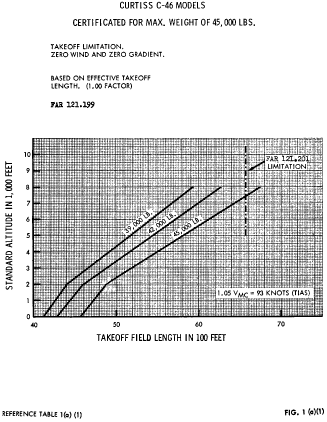

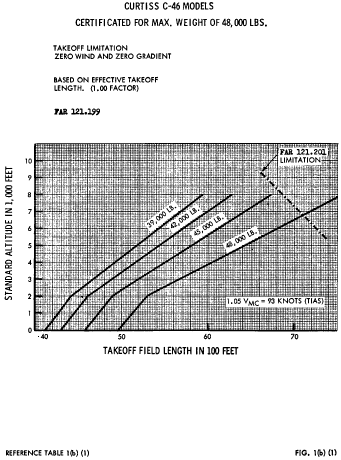
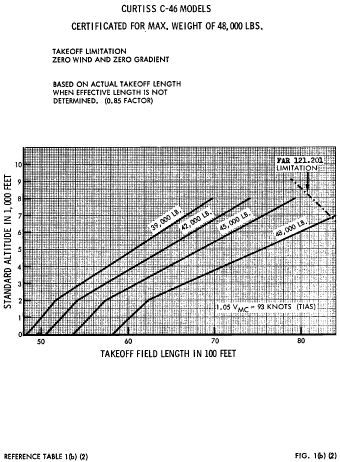
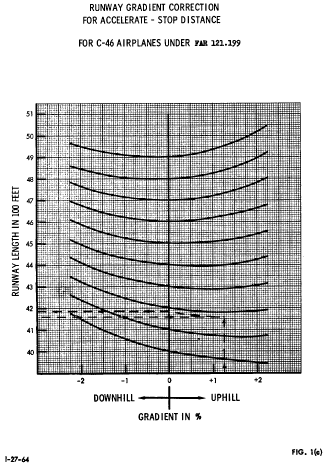
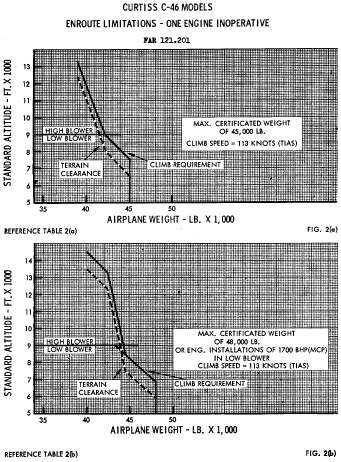
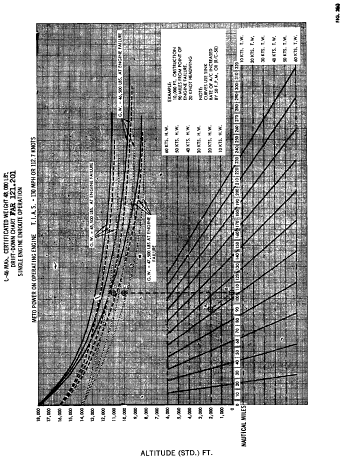

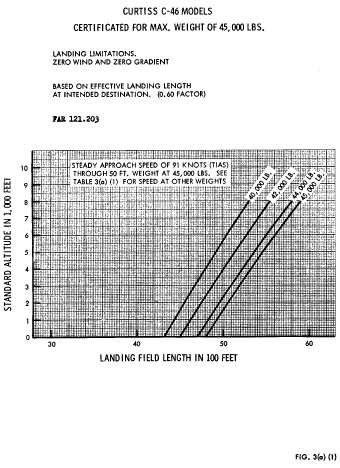
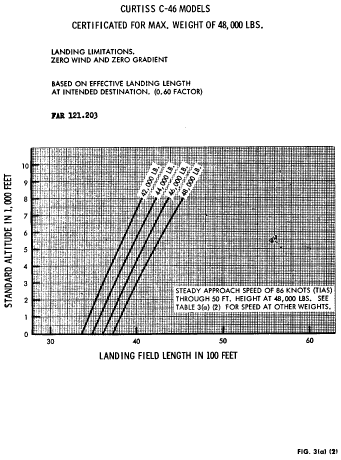

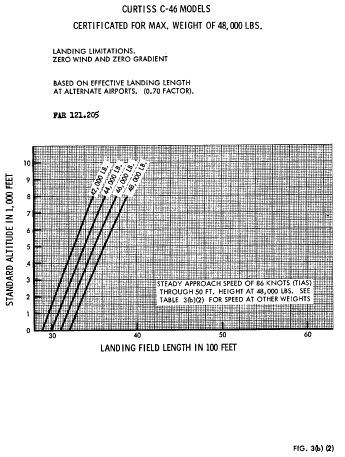

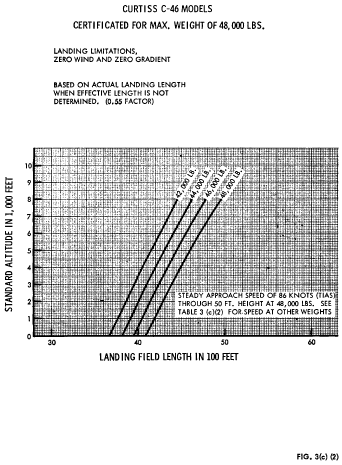
[Doc. No. 4080, 30
FR 258, Jan. 3, 1965; 30 FR 481, Jan. 14, 1965, as amended by Amdt.
121-207, 54 FR 39293, Sept. 25, 1989; Docket FAA-2018-0119, Amdt.
121-380, 83 FR 9173, Mar. 5, 2018]













 [Doc. No. 4080, 30
FR 258, Jan. 3, 1965; 30 FR 481, Jan. 14, 1965, as amended by Amdt.
121-207, 54 FR 39293, Sept. 25, 1989; Docket FAA-2018-0119, Amdt.
121-380, 83 FR 9173, Mar. 5, 2018]
[Doc. No. 4080, 30
FR 258, Jan. 3, 1965; 30 FR 481, Jan. 14, 1965, as amended by Amdt.
121-207, 54 FR 39293, Sept. 25, 1989; Docket FAA-2018-0119, Amdt.
121-380, 83 FR 9173, Mar. 5, 2018]